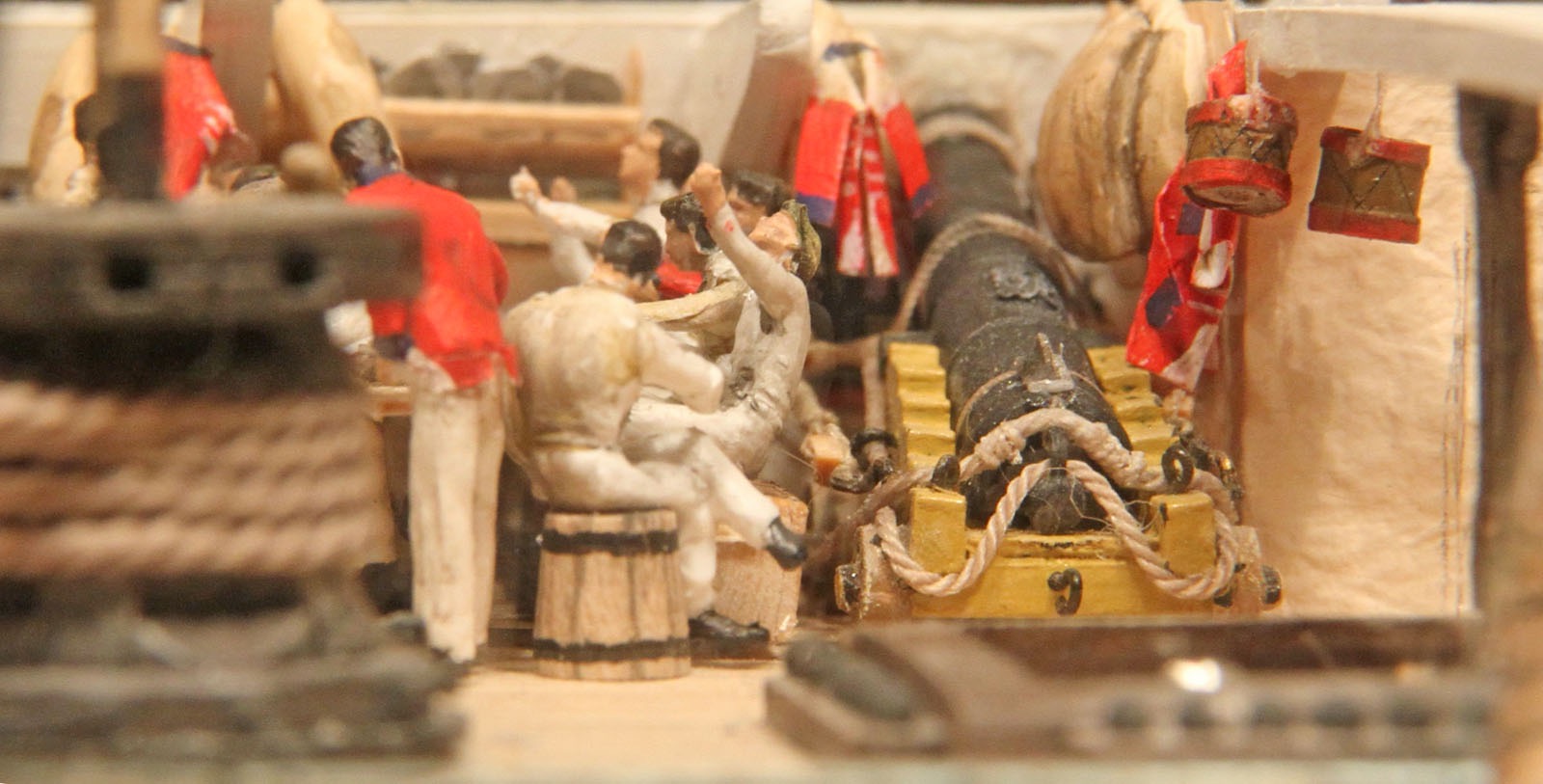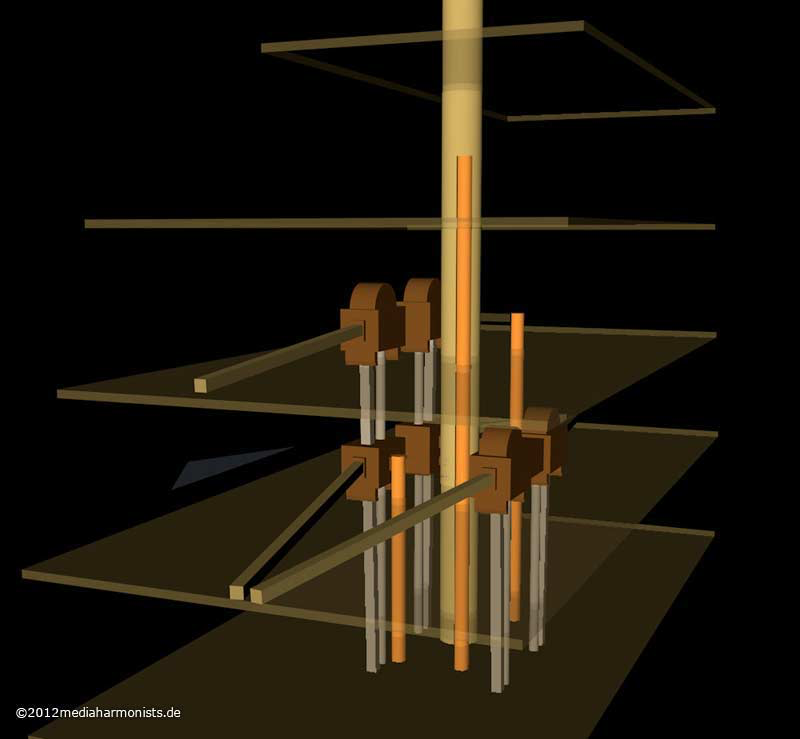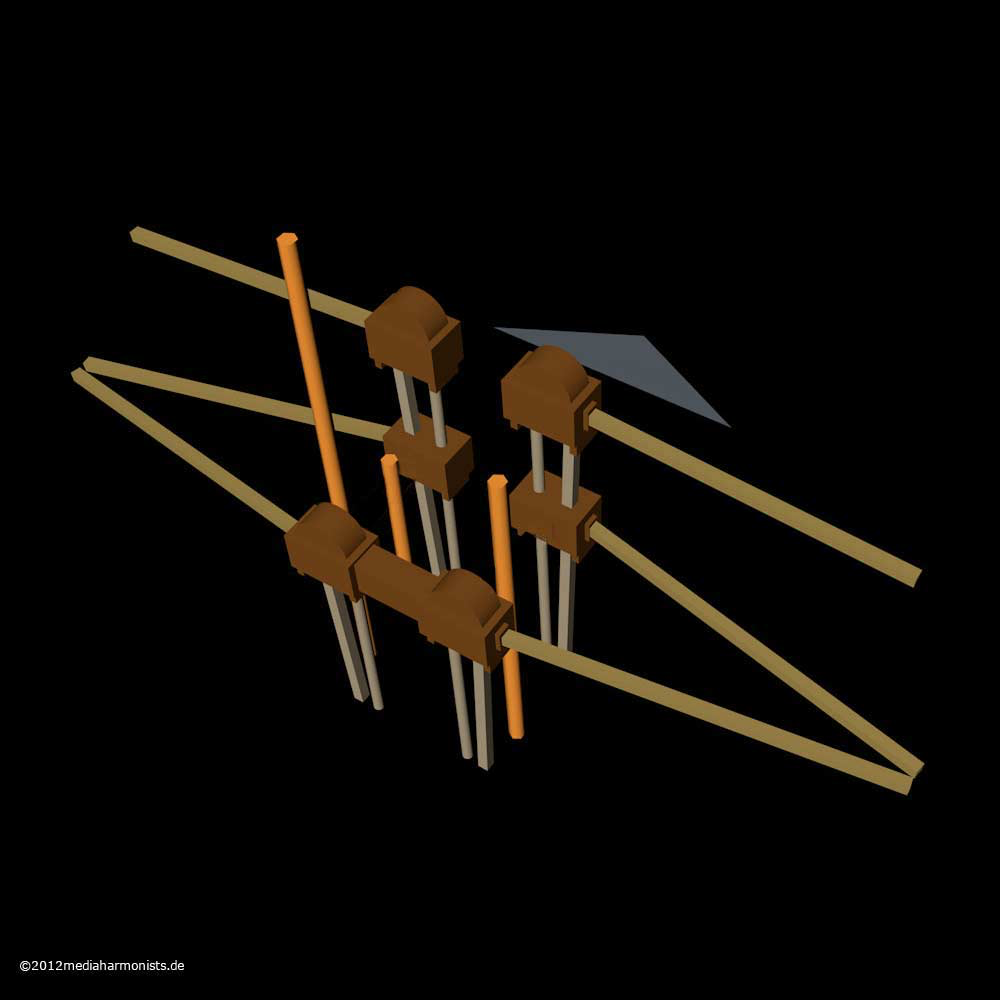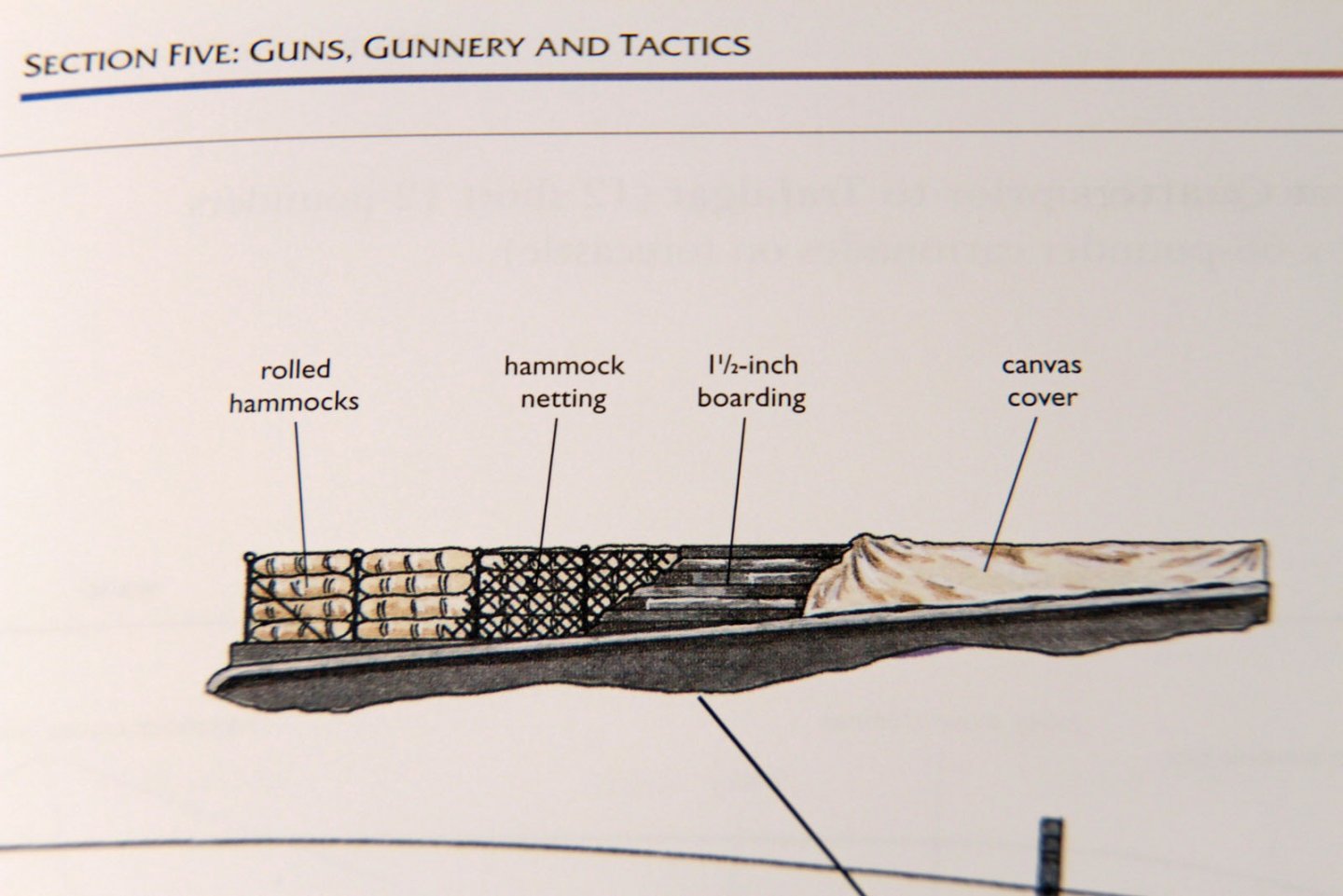-
Posts
2,417 -
Joined
-
Last visited
Content Type
Profiles
Forums
Gallery
Events
Everything posted by dafi
-
I always understood that those eyebolts on the outside were a french/continental preference. The english preferred just spikes on the inside for as far as I recall for impermeability and anti-rotting reasons. I remember once reading about a vicious comment about the all those frensh "iron ships". XXXDAn
-
Thank you! Profiling the coaming: First a slight curvature analogous to the camber, and then the edges rounded. Still tinkered some more gratings, ... [/img] ... and all fitted together. Here in a closed state, ... ... and here open. The whole set open in situ 🙂 Here the slots in the grating for the rudder rope. And closed in situ. XXXDAn
-
Here still on request as a supplement the hidden stern port from Goodwin's "operating manual".... The other day - about 8 years ago or so - I had the companionway installed next to the capstan. But as is so often found on English ships, there was a companionway just inside the capstan bars´ turning circle. But how was this companionway closed when the capstan was operated? The first thing to notice was that the already made coaming on the model was not complete. As what do you do in such a case? One swings the blade ... ... and builds a new coaming 🙂 Of course, the sharp-eyed observer will not miss the fact that there is a small 90° twist here in coming n#1. So I had to do it again and here it is the new quadruple coaming combination, from left to right: In the first field comes the rope for the tiller cable, then the companionway, a free coaming and the enclosure of the capstan. Today in P. there is a grating underneath the capstan. However, since the contemporary models I know have a solid two-piece wooden plate there, I decided to use one as well. The adjacent panel I have provided with a grating, so there can be a visual and auditory contact between the decks. The companionway here is covered by simply planks. Quick and effective to set up and clear away. Possibly the companionway could also have been covered by a grating. Therefore I covered the field in the direction of the capstan with planks. Or as seen on the Amazon class Frigate model in the NMM SLR0315 https://collections.rmg.co.uk/collections/objects/66276.html a double leaf flap. Very elegant solution. Closed it's good to walk on, open it also serves as a railing and doesn't need to be stowed anywhere else. https://www.mediaharmonists.de/bilder/Sammler34/Victory-Spill-210120_6593.jpg Also the flaps can be opened when the capstans bars are fixed. Could this be a way of solving the mystery of how to close the companionway? ... XXXDAn
-
Back to the conductors 🙂 We had a good discussion about the theme in our german forum: https://www.segelschiffsmodellbau.com/t1912f643-Blitzableiter-an-Schiffen.html Also NMM has nice exhibits 🙂 http://collections.rmg.co.uk/collections/objects/63401.html REL0295 Main royal masthead from French flagship 'L'Orient' which exploded during the battle of the Nile. Lord Minto mentions it on display at Nelson's house at Merton in 1802. Pine mast with an iron fitting, which contains a sheave to take the signal halyard. A brass lightning conductor inscribed 'L'Orient' is attached to the top, bent in a loop. The whole is fixed to a square stand. [It is probably more accurate to date it to 'circa 1795', since the ship was under construction in 1793 (when the British failed to burn her on the stocks at Toulon) and it was certainly made and fitted before the Battle of the Nile when it was taken up from the sea after 'L' Orient' exploded. PvdM 2/13] Date made circa 1798 Also the museum in Amsterdam has a nice model equipped with one: XXXDAn
-
And in order not to frighten the suspicious and spoiled audience, we continue with another dismantling. First, a look at the scene of crime, the middle battery deck. The normal tiller is located in the lower battery deck under the deck beams. The picture shows in the foreground how the rudder head protrudes into the middle battery deck, with the slot for the emergency tiller in case the lower one is damaged. Handy in times of storm and battle. On the Vic in P., the rudder head is covered with an 8-cornered oval cowl. So far I haven't found such a part in the contemporary records. The contemporary model of the Princess Royal and other models show a cowl that goes all the way to the rear seat under the windows. So snap away the current cover ... ... and new window seats, using a figure to determine the seat height, the total height was determined by the lower edge of the window. The depth is based on the model of the Princess Royale. After some fiddling, the cover and the two benches were built. Another cutter blade was profiled to be able to score the surrounding profile ... ... and the whole lot adjusted in place. That's when the great depth caught my eye. Even though it was certainly used for storage, it was much too deep. In case of battle, both the bench and the cover would have been dismantled to get to the hidden stern chasing ports. And you can see now on the gun how much space is wasted in this version with the bench. Here again the rudder head ... ... with the slot for the emergency tiller. So I shorten the bench a bit in depth. Here the port side has already been shortened ... ... and here the other side as well. And our master is having a good time 🙂 Then another blade was profiled and a drawing iron made for the frame lining of the window frames. And this is how it looks now 🙂 XXXDAn
-
Before resuming the main trail, I had to clean and look for parts. I was also asked how big my little one could get, and to my shame I have to confess that after more than 10 years I didn't even know ... So I put in the jib, the flying jib and the gaff boom and hung up the mainsail yard with the stun´sail spars. So the dimensions were taken: 105 cm x 52 cm x 73 cm. Good that I know now 🙂 Here are some pictures of the actual state. But you guessed it, setting main yard was not done so quickly. 1805 was in the middle of the war and Lees describes that the lower yard slings were replaced by chains during this war periods. As I had a piece of chain of the right length, this was immediately used for this purpose. But in the process it was noticed that the two scuttles for this were still missing in the main fighting top, as was the nailing ... ... so this was quickly done. Here the comparison with the fore top: brown is the kit, white the new structure, as the tops were to be built in two parts from 1802 onwards to simplify repairs. And then the main yard could be finally set, correctly with chain 🙂 Note the following detail: On the starboard side, the stopper cleat of the square rig is shaped like a bow, as it is on the Vic today. On the port side it is formed as a shoulder, as shown by Lees, Schrade and some contemporary models. I have not yet been able to find out which variant was used when. As always, questions about questions. XXXDAn
-
Thank you SIrs! Happy new year! And what better way to celebrate than with a proper demolition, something I had already planned for some time. In September 2010, I was quite happy for one more rare occasion again, to be able to glue a part coming straight from the casting branch, just as the god of molds created it, directly to the model without pimping or without any further fuss. See here it is, the little crown ... ... by now I'm pretty sure that was not placed there around 1805. Probably an invention of 1920, when restoring to the Trafalgar state, for lack of better knowledge at that time. As the beam is called cathead, there usually was a cat's or lion's head on it in the initial phase. At the time of the Victory's construction, however, a kind of compass rose was common, sometimes also an anchor. Since the 1765 model of the Vic shows this compass rose and also the 1805 model, which was wrongly called "Victory", had such a rose, I felt quite confident to skip my sweet little crown with a light heart. I made a compass rose out of modeling clay, and since the dimensions were tiny and tight, I printed the outlines on baking paper and was thus able to easily form to the true dimensions and to detach the fragile structure. Once fit test on a replacement cathead with a specimen that proved too thick ... ... and I bravely swung the blade. The new part was quickly glued in place ... ... and still a little paint was put on it. And as a gif it gives a little impression of the depth effect. Enjoy 🙂 I know I've had other demolition orgies before, I just got out of practice 😉 All the best, Daniel
-
And last but not least the best known version, the ship as it stands today in Portsmouth. Like new from the egg, no wear or tear, a nice museum ship as expected 😉 But even though all the anachronisms and contradictions towards the few contemporary sources still an amazing artifact that allows a bit of time traveling 🙂 But still I think no one today can imagine the true hardship and discomfort and dangers of those days. Physical, emotional and psychological. Once a death bringing fighting machine, today it is a tourist attraction. Families and playing kids instead of powder monkeys and expendables wear parts ... Here are some more details to enjoy. But even this museum ship is undergoing the flux of changes. While bringing it back to the Trafalgar condition, the color "yellow" was misinterpreted and a cadmium yellow was applied, still to be found in many kits descriptions. Once it was understood that "yellow ochre" was meant the ship was changed to the buff seen on many contemporary paintings. Sometimes the chain irons were included in the stripe scheme, sometimes they were complete black. Newest research suggests a terra cotta tone for the hull, believing that the usual yellow ochre was short in the yard and the paint was stretched with red and white. Also the hammock netting I saw already dark and light, the name on the stern I know in 3 different versions - even though I personally strongly believe it was omitted at Trafalgar for intelligence reasons - the stern davits were fitted in the past and taken down again. And much more ... So this means, even if one builds a model of the museums ship, one has quite well determinate, what year it is meant to represent 😉 In this sense I might close this small side project and wish you all a happy new year! Stay healthy!!! XXXDAn PS: I still am waiting for those furious screams of panic once they adopt more research onto the ship in P., taking down the Feathers of Wales and the side davits, build the solid forecastle barricade and best of all, close the side entry port ...
-
In the repair of 1814 to 1816 the Victory was fitted with the new round bow and solid hammock cases. About 1837 the Feathers of Wales were fixed on the stern, still being there today. In 1859 the ship got the last set of wooden mast, later on the steel masts from HMS Shaw. Somwhere in the 1860 the planking was removed and the new planking was flush, wales omitted. Also that time she most possibly got the stern decoration that can be seen on the early photographies. But these were only the outer signs, on the inside the hanging magazines were already removed by 1814 and every change in duty caused bigger changes in the internal layout. There are hundreds of pictures of the pre 1920 Victory, an appearance that lasted more than a 100 years, but still this is one is the version that is the least often build as a model ... The planking was flush, the rigols were straight and the ports had window frames. In the upper and lower batterie there were still some historical guns from Trafalgar on display. In the middle battery there were 7 salute guns of modern design, 4 on one side, 3 on the other. The chain boards were shortened, the number of shrouds reduced. All along the hull there were waste pipes going down. Picturesque are all the stove pipes going up 🙂 The officer is wearing a 1910 uniform with flat cap and short jacket, his camera is a contemporary Agfa-Photo-Box. The sailors have their uniforms with large hat and extra large collar, one in white, one in blue 🙂 The inspiration for this scene is the sailor from submarine C34, looking up to the chains. In those days it was quite common for a submarine to be docked alongside, as their generators supplied electricity for the older ship. But was this sailor from C34 seeing? Possibly something like this.
-
The most iconic appearance of the Victory is the one of Trafalgar. And this is also the most obscure one, as it lasted the shortest and was almost not documented. Contemporary sources are very thin, as the great repair took place under pressure of time in the height of the raging war, and proper documentation did not take place or at least is not known. Quite sure is, that the channel boards were moved on top of the ports, and of course the stern was most possibly closed in. Most actual details can be found in Turner´s sketches as he draw some scribbles after the ship came back. Nicely seen is the build barricade of the forecastle, other details like the anchor lining are more obscure and subject of interpretation and discussion. Also th be guessed are the thinner black stripes and the yellow gunport lids. Biggest ongoing discussion is the color of the yellow. Today a light terra cotta, in contrast to the usual yellow buff as seen in contemporary paintings. The actual guess is that the yards were short on buff and stretch it with red and white witch was available. Any way my personal believe is that ships of that age - as we were before industrial RAL definitions - were much more a patchwork of different colors, just always the surprise which shade would come out of the barrel of paint. That is also the story I am telling here, the two sailors applying the shade of ochre that the ship is painted today 🙂 Our Royal Marine now wears the new uniform introduced from about 1800 onwards, with round head, no revers and no swallow tails. The other sailors wear still no uniform yet. Difficult to see on Turners oeuvre is the anchor lining. But still a quite too useful installation to miss it out. On the channel boards one can see the partner for the short fishing davit. For the 68 pounder carronade - taken over in 1804 from the Kent - the railing on the barricade has a hinge to protect it from the muzzle flash and to facilitate handling. And as mentioned already before, thanks to @Morgan for all his great hints and input!!!
-
Thank you Sirs 🙂 🙂 And here come some more detail shots. First the in my humble opinion most beautiful appearance of this ship 🙂 The channel boards still in the lower position underneath the ports, the painted friezes and the hull paid with rosin. The Royal Marine still wears the uniform from about 1780, with the tricorn, the long swallow tails on the coat, the broad revers and the stockings. The holystoning gentlemen did not wear a special uniform yet. This was the time by the way, that the holystoning of the decks became quite excessive. If the Victory was still carrying the original bronze guns or the newer iron cast ones in 1780 I could not yet finally judge. But to show the changes of the ship through the years I opted for the original version for this display. Other nice details are the anchor lining, the 4-piece irons with the eyebolts in between and the bolster for the long fishing davit in between the timber heads. Also a nice detail is the lanyard of the fore gunport lid that is guided elegantly up to the timberhead of the forecastle 😉 Based on the contemporary model from the Victory from 1765. https://collections.rmg.co.uk/collections/objects/66473.html XXXDAn
-
Grande Finale 🙂 Finally I found the time to do the last beauty shots of my little series of my 5 slices.. It was a most exciting project, that started with simply trying out new resin, took off by itself, and developed into nice display on the history of that grat ship. Already longer finished was the rigged version of a 1805 first rate. Now come the version as build from about 1780, the actual state of my research for the iconic 1805 version, the black and white version of past 1910 and the latest version of the museums ship in its past 2016 look. Here the overview. Travelling times in 4 pictures 🙂 We start with the beauty of the as build version, with its nice friezes and - not visible - the wonderful carvings on head and stern. The best known version is the least known by far. Done under pressure of time there is no known documentation. Here shown is the intermediate result of my research so far. The biggest changes were suffered from 1814 on to 1920. The planking was removed and the new one was flush without any wales. The bow was reconstructed as a round bow, the hammocks got build cases and the masts were replaced by smaller steel ones with a reduced number of shrouds. Seen by todays eyes a pity but still the historical version that lasted the longest. And of course the version that is the best known, the almost complete reconstruction in Portsmouth 😉 Even with many anachronisms and differences to contemporary sources, this ship gives a nice impression onto how ships may have looked in the old days, a pleasure to be there and see 🙂 XXXDAn
-
Hello @jock2000 Nice to hear from you! Yes that is correct. you can use Heller as reference, they did the positioning nicely. All the best, happy modeling, Daniel
-
Cäptn dafi´s log, addendum: At the last stop in the Victory-Univers we were able to complete the crew. First we got the much needed cleaning team ... ... and then still came Cäptn dafis superior in form of the admirability herself. Final spurt 🙂 XXXDAn
-
Hello @97Bill, as I am far off having started the yards, I have no idea about the dimensions yet. My guess is 80 cm height, length 100 cm+ and the width 35 cm (65+ with stunsails). @Kelp I used the copper in the exact width and ran them down in long lines, not single plates. A toothpick was great to form the overlap of tiling. And it holds perfect to the date, several years already on there. XXXDAn
-
The only gun drill on film I know that is quite true is on Master and Commander , especially on the bonus disc. All other ones are not very trustable, the idle members just standing around "bored", also having all the space in the world, as the neighbor crews are missing ... I tried some time ago to give a better impressen onto this topic here: XXXDAn
-
As there is an ongoing discussion about Victory´s midship section at the very moment, I would like to bring up this topic again, that still puzzles me. And I think others too 😉 I also realised, that I never presented the renderings I did those days trying to understand the possible setup on the Victory in about 1788 to 1805. As said before, a mere guess based upon the available sources. The 3 light brown tubes are the elm tree pumps. For the "long" pump I opted for no cogwheel in the lower deck, therefor no half round hood. All the best, DAniel
-
Have a look at NMM for plans of other first, second and third rates of that period. All layouts are identical. Just look for the bigger changes in the layout and when they took place. Then you should be able to create a quite accurate and true model :-) For the deck section in front of the main mast, you have a great reference in the 1765 models displayed in NMM. XXXDAn
-
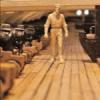
Paper on HMS Swift: British Sloop-of- War lost off Patagonia 1770
dafi replied to bruce d's topic in Nautical/Naval History
Thank you for showing! XXXDAn -
Dod you consider to show the hammocks in a covered mode? Just a block of balsa or foam in the right dimensions, and some paper handkerchiefs with some PVA applied can do a great job in your scale to represent the canvas cover. Here is a tarred version 🙂 https://collections.rmg.co.uk/collections/objects/66307.html XXXDAn
-
As I am a very shy and ´umble person, I forgot to present myself 😉 So I looked for a template ... https://www.mediaharmonists.de/bilder/Sammler33/Utrecht-170527_3805-(1).jpg ... carved a tiny bit ... https://www.mediaharmonists.de/bilder/Sammler33/IMG_1141-(1).jpg ... and here it is the small minni-me 🙂 https://www.mediaharmonists.de/bilder/Sammler33/IMG_1147-(1).jpg https://www.mediaharmonists.de/bilder/Sammler33/IMG_1149-(1).jpg Even with my silver medal present 😉
About us
Modelshipworld - Advancing Ship Modeling through Research
SSL Secured
Your security is important for us so this Website is SSL-Secured
NRG Mailing Address
Nautical Research Guild
237 South Lincoln Street
Westmont IL, 60559-1917
Model Ship World ® and the MSW logo are Registered Trademarks, and belong to the Nautical Research Guild (United States Patent and Trademark Office: No. 6,929,264 & No. 6,929,274, registered Dec. 20, 2022)
Helpful Links
About the NRG
If you enjoy building ship models that are historically accurate as well as beautiful, then The Nautical Research Guild (NRG) is just right for you.
The Guild is a non-profit educational organization whose mission is to “Advance Ship Modeling Through Research”. We provide support to our members in their efforts to raise the quality of their model ships.
The Nautical Research Guild has published our world-renowned quarterly magazine, The Nautical Research Journal, since 1955. The pages of the Journal are full of articles by accomplished ship modelers who show you how they create those exquisite details on their models, and by maritime historians who show you the correct details to build. The Journal is available in both print and digital editions. Go to the NRG web site (www.thenrg.org) to download a complimentary digital copy of the Journal. The NRG also publishes plan sets, books and compilations of back issues of the Journal and the former Ships in Scale and Model Ship Builder magazines.

